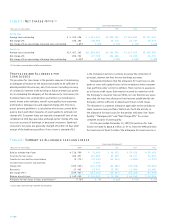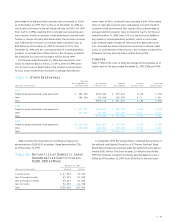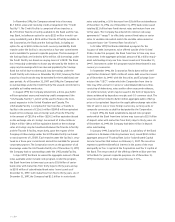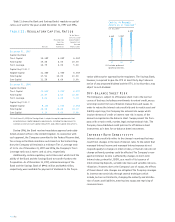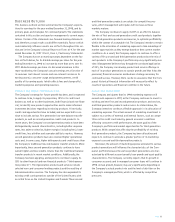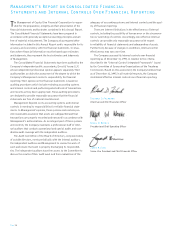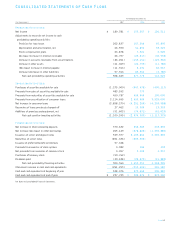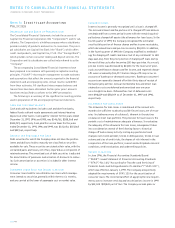Capital One 1997 Annual Report Download - page 37
Download and view the complete annual report
Please find page 37 of the 1997 Capital One annual report below. You can navigate through the pages in the report by either clicking on the pages listed below, or by using the keyword search tool below to find specific information within the annual report.Business Outlook
This business outlook section summarizes the Company’s expecta-
tions for earnings for the year ending December 31, 1998, and its
primary goals and strategies for continued growth.The statements
contained in this section are based on management’s current expec-
tations. Certain of the statements are forward looking statements
and, therefore, actual results could differ materially. Factors which
could materially influence results are set forth throughout this sec-
tion and in the Company’s Annual Report on Form 10-K for the year
ended December 31, 1997 (Part I, Item 1, Cautionary Statements).
The Company has set an earnings target, dependent on the fac-
tors set forth below, for its diluted earnings per share for the year
ending December 31, 1998 to increase by more than 20% over its
1997 diluted earnings per share. As discussed elsewhere in this
report and below, the Company’s actual earnings are a function of
its revenues (net interest income and non-interest income on its
earning assets), consumer usage and payment patterns, credit
quality of its earning assets (which affects fees and charge-offs),
marketing expense and operating expenses.
Product and Market Opportunities
The Company’s strategy for future growth has been, and is expected
to continue to be, to apply its proprietary IBS to its credit card
business as well as to other businesses, both financial and non-finan-
cial, to identify new product opportunities and to make informed
investment decisions regarding its existing products. Historically,
credit card opportunities have included, and are expected to con-
tinue to include, various first generation low-rate balance transfer
products, as well as second generation credit card products. In
recent years, the Company’s second generation products have been
distinguished by several characteristics, including better response
rates, less adverse selection, higher margins (including fees), lower
credit lines, less attrition and a greater ability to reprice. However,
second generation products have also involved higher operational
costs and, in some cases, higher delinquencies and credit losses than
the Company’s traditional low rate balance transfer products. More
importantly, these second generation products continue to have
overall higher and less volatile returns than the traditional balance
transfer products in recent market conditions. Additionally, the
Company has been applying, and expects to continue to apply, its
IBS to other financial and non-financial products (“third genera-
tion products”).Third generation products and services include
selected non-card consumer lending products and the reselling of
telecommunication services.The Company has also expanded its
existing credit card operations outside of the United States, with
an initial focus on the United Kingdom and Canada.These second
and third generation products are subject to competitive pres-
sures, which management anticipates will increase as these
markets mature.
The Company continues to apply its IBS in an effort to balance
the mix of first and second generation credit card products together
with third generation products and services, to optimize profitability
within the context of acceptable risk.The Company intends to remain
flexible in the allocation of marketing expenses to take advantage of
market opportunities as they emerge based on then current market
conditions. As a result, the Company expects to continue to offer a
variety of first, second and third generation products but the mix of
such products in the Company’s portfolio may vary significantly over
time. Management believes that, through the continued application
of IBS, the Company can develop product and service offerings in
each of its product generations to sustain growth and that it has the
personnel, financial resources and business strategy necessary for
continued success. However, there can be no assurance that the Com-
pany’s historical financial information will necessarily reflect its
results of operations and financial condition in the future.
Marketing Investment
The Company anticipates that its 1998 marketing expenses will
exceed such expenses in 1997, as the Company continues to invest in
existing and new first and second generation products and services,
and third generation products and services. As stated above, the
Company intends to continue a flexible approach in its allocation of
marketing expenses.The actual amount of marketing investment is
subject to a variety of external and internal factors, such as compe-
tition in the credit card industry, general economic conditions
affecting consumer credit performance, the asset quality of the
Company’s portfolio and market opportunities for third generation
products.With competition affecting the profitability of existing
first generation products, the Company has been allocating and
expects to continue to allocate a greater portion of its marketing
expense to second and third generation products.
Moreover, the amount of marketing expense allocated to various
product generations will influence the characteristics of the Com-
pany’s portfolio because the various product generations are char-
acterized by different account growth, loan growth and asset quality
characteristics.The Company currently expects that its growth in
consumer accounts and in managed consumer loans will continue in
1998. Actual growth, however, may vary significantly depending on
the Company’s actual product mix and the level of attrition on the
Company’s managed portfolio, which is affected by competitive
pressures.
PAGE 35





